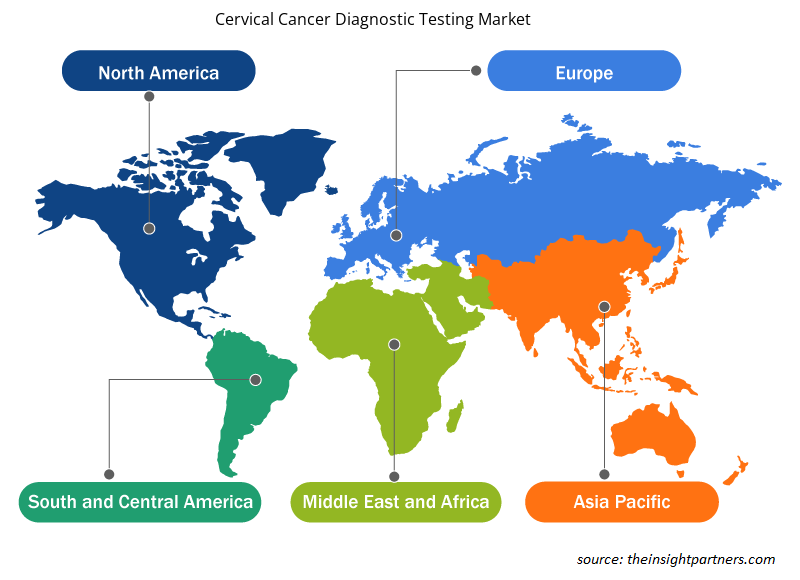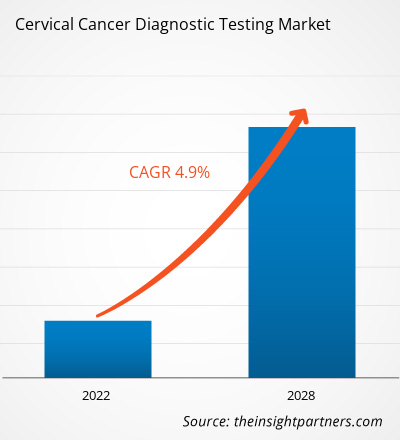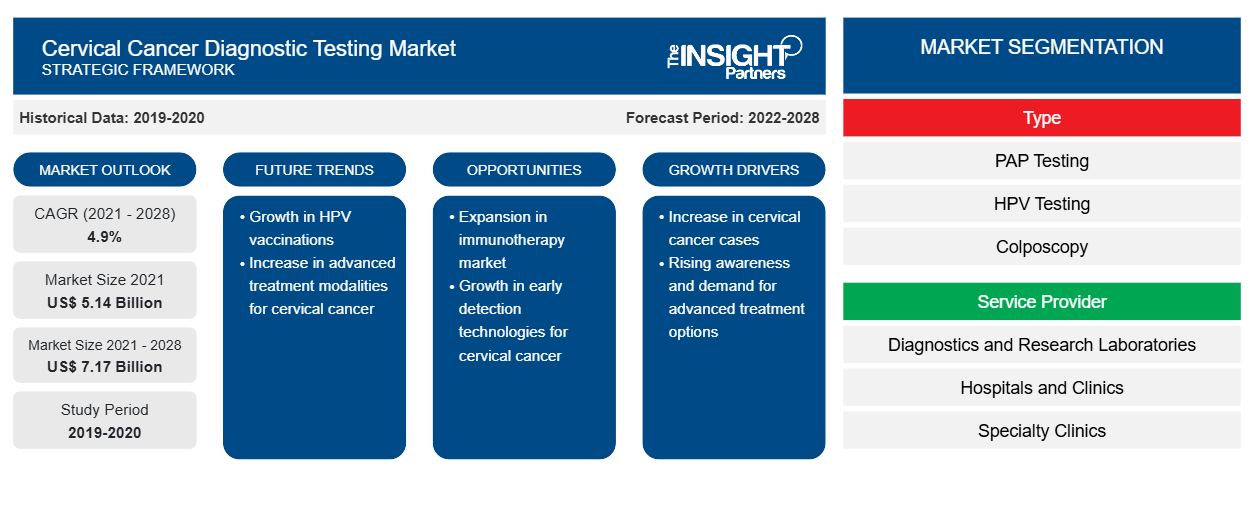Le marché des tests de diagnostic du cancer du col de l'utérus devrait atteindre 7 165,92 millions USD d'ici 2028, contre 5 141,25 millions USD en 2021 ; il devrait croître à un TCAC de 4,9 % de 2021 à 2028.
Le cancer du col de l'utérus a un taux de mortalité important (près de 50 %), qui peut être réduit par une détection et une prévention précoces. Les altérations précancéreuses offrent des possibilités de prévention et de traitement car la progression de la maladie est souvent retardée. Cependant, en raison d'un manque de sensibilisation ou d'accès aux services de diagnostic, de nombreux cas sont détectés à des stades ultérieurs de la progression de la maladie. Le papillomavirus humain (HPV) est l'une des principales causes du cancer du col de l'utérus, qui se transmet généralement par contact sexuel. Il existe plus de 100 souches de HPV, dont 13 sont à haut risque ou cancérigènes. Le gène actif - E6 ou E7 - détermine si une souche de HPV est à haut ou à faible risque. E6 se lie à p53, provoquant une destruction protéolytique. E7, en revanche, se lie au rétinoblastome ; la liaison déplace les facteurs de transcription précédemment attachés, ce qui entraîne l'arrêt du cycle cellulaire et l'inhibition de la régulation de l'apoptose. Le test HPV détecte le papillomavirus humain dans les cellules cervicales. D'autres approches de dépistage employées dans les zones à faibles ressources des pays en développement sont le test ADN HPV et l'inspection visuelle. Le dépistage régulier du cancer du col de l'utérus contribue à la détection précoce du cancer du col de l'utérus, réduisant ainsi le taux de mortalité lié à la maladie. Tous les trois ans, il est conseillé à toutes les femmes âgées de 21 à 65 ans de passer un test Pap, et aux femmes âgées de 30 à 65 ans de passer à la fois un test Pap et un test HPV. En termes de revenus, ce type de test a dominé le marché du dépistage du cancer du col de l'utérus en 2021, et il devrait continuer à dominer au cours de la période de prévision.
Personnalisez ce rapport en fonction de vos besoins
Vous bénéficierez d'une personnalisation gratuite de n'importe quel rapport, y compris de certaines parties de ce rapport, d'une analyse au niveau des pays, d'un pack de données Excel, ainsi que de superbes offres et réductions pour les start-ups et les universités.
- Obtenez les principales tendances clés du marché de ce rapport.Cet échantillon GRATUIT comprendra une analyse de données, allant des tendances du marché aux estimations et prévisions.
Perspectives du marché
L'augmentation de la prévalence du cancer devrait stimuler la croissance du marché des tests de diagnostic du cancer du col de l'utérus au cours de la période de prévision
Le cancer est devenu l'une des principales causes de décès dans le monde. Selon l'Organisation mondiale de la santé (OMS), le cancer était la première cause de décès chez les personnes de moins de 70 ans dans 183 pays et la quatrième cause de décès dans 123 pays du monde en 2019. En outre, selon les données publiées par l'OMS en mars 2021, environ 10 millions de décès sont survenus en 2020 en raison de différents types de cancer. L'incidence croissante du cancer du col de l'utérus chez les femmes dans le monde entier stimule la croissance du marché des tests de diagnostic du cancer du col de l'utérus . Selon l'OMS, plus de 270 000 décès de femmes sont enregistrés chaque année en raison du cancer du col de l'utérus. Les taux de mortalité par cancer du col de l'utérus sont plus élevés dans les pays à faible revenu en raison du diagnostic tardif de la maladie. Le marché devrait croître dans les années à venir en raison de l'acceptation croissante des tests de diagnostic du cancer du col de l'utérus pour la détection précoce de la maladie.
La prévalence croissante du cancer a créé un fardeau pour les systèmes de santé du monde entier. Selon le Centre international de recherche sur le cancer (CIRC), le nombre de nouveaux cas de cancer devrait atteindre environ 27,5 millions d’ici 2040, et la maladie pourrait être à l’origine d’environ 163 millions de décès d’ici cette même année. Des facteurs tels que les changements de mode de vie, le tabagisme, la réduction des activités physiques et les conditions sanitaires et climatiques incertaines pourraient aggraver encore le fardeau du cancer dans le monde dans les années à venir.
Informations basées sur les types
En fonction du type, le marché des tests de diagnostic du cancer du col de l'utérus est segmenté en tests PAP, tests HPV , colposcopie, biopsies cervicales, cystoscopie et autres. En 2021, le segment des tests PAP détenait la plus grande part du marché et il devrait enregistrer le TCAC le plus élevé au cours de la période 2021-2028.
Informations basées sur les fournisseurs de services
En fonction du fournisseur de services, le marché est segmenté en laboratoires de recherche, de diagnostic et de recherche, hôpitaux et cliniques, cliniques spécialisées et services de soins à domicile. En 2021, le segment des laboratoires de diagnostic et de recherche détenait la plus grande part du marché et devrait enregistrer le TCAC le plus élevé du marché au cours de la période 2021-2028.
Les entreprises opérant sur le marché des tests de diagnostic du cancer du col de l'utérus adoptent diverses stratégies telles que les innovations de produits, pour répondre à l'évolution des demandes des clients à travers le monde et maintenir leur nom de marque sur le marché mondial.
Marché des tests de diagnostic du cancer du col de l’utérus – Segmentation
Le marché des tests de diagnostic du cancer du col de l'utérus est segmenté en fonction du type et du prestataire de services. En fonction du type, le marché est sous-segmenté en tests PAP, tests HPV, colposcopie, biopsies cervicales, cystoscopie et autres. En fonction du prestataire de services, le marché est encore segmenté en laboratoires de diagnostic et de recherche, hôpitaux et cliniques, cliniques spécialisées et services de soins à domicile.
En termes de géographie, le marché des tests de diagnostic du cancer du col de l'utérus est segmenté en Amérique du Nord (États-Unis, Canada et Mexique), Europe (France, Allemagne, Italie, Royaume-Uni, Espagne et reste de l'Europe), Asie-Pacifique (Australie, Chine, Inde, Japon, Corée du Sud et reste de l'APAC), Moyen-Orient et Afrique (Arabie saoudite, Afrique du Sud, Émirats arabes unis et reste de la MEA) et Amérique du Sud et centrale (Brésil, Argentine et reste de la SCAM).
Aperçu régional du marché des tests de diagnostic du cancer du col de l'utérus
Les tendances et facteurs régionaux influençant le marché des tests de diagnostic du cancer du col de l’utérus tout au long de la période de prévision ont été expliqués en détail par les analystes d’Insight Partners. Cette section traite également des segments et de la géographie du marché des tests de diagnostic du cancer du col de l’utérus en Amérique du Nord, en Europe, en Asie-Pacifique, au Moyen-Orient et en Afrique, ainsi qu’en Amérique du Sud et en Amérique centrale.

- Obtenez les données régionales spécifiques au marché des tests de diagnostic du cancer du col de l'utérus
Portée du rapport sur le marché des tests de diagnostic du cancer du col de l'utérus
| Attribut de rapport | Détails |
|---|---|
| Taille du marché en 2021 | 5,14 milliards de dollars américains |
| Taille du marché d'ici 2028 | 7,17 milliards de dollars américains |
| Taux de croissance annuel moyen mondial (2021-2028) | 4,9% |
| Données historiques | 2019-2020 |
| Période de prévision | 2022-2028 |
| Segments couverts | Par type
|
| Régions et pays couverts | Amérique du Nord
|
| Leaders du marché et profils d'entreprises clés |
|
Densité des acteurs du marché des tests de diagnostic du cancer du col de l'utérus : comprendre son impact sur la dynamique commerciale
Le marché des tests de diagnostic du cancer du col de l'utérus connaît une croissance rapide, tirée par la demande croissante des utilisateurs finaux en raison de facteurs tels que l'évolution des préférences des consommateurs, les avancées technologiques et une plus grande sensibilisation aux avantages du produit. À mesure que la demande augmente, les entreprises élargissent leurs offres, innovent pour répondre aux besoins des consommateurs et capitalisent sur les tendances émergentes, ce qui alimente davantage la croissance du marché.
La densité des acteurs du marché fait référence à la répartition des entreprises ou des sociétés opérant sur un marché ou un secteur particulier. Elle indique le nombre de concurrents (acteurs du marché) présents sur un marché donné par rapport à sa taille ou à sa valeur marchande totale.
Les principales entreprises opérant sur le marché des tests de diagnostic du cancer du col de l'utérus sont :
- F. HOFFMANN-LA ROCHE LTÉE.
- Abbott
- Quest Diagnostics Incorporated
- QIAGEN
- Hologic, Inc.
Avis de non-responsabilité : les sociétés répertoriées ci-dessus ne sont pas classées dans un ordre particulier.

- Obtenez un aperçu des principaux acteurs du marché des tests de diagnostic du cancer du col de l'utérus
Profils d'entreprise
- F. Hoffmann-La Roche Ltée.
- Abbott
- Quest Diagnostics Incorporated
- QIAGEN
- Hologic, Inc.
- DYSIS Médical Inc.
- Femasys Inc.
- Thérapeutique guidée, Inc.
- Sociétés Cooper, Inc.
- BD
- Analyse historique (2 ans), année de base, prévision (7 ans) avec TCAC
- Analyse PEST et SWOT
- Taille du marché Valeur / Volume - Mondial, Régional, Pays
- Industrie et paysage concurrentiel
- Ensemble de données Excel
Rapports récents
Rapports connexes
Témoignages
Raison d'acheter
- Prise de décision éclairée
- Compréhension de la dynamique du marché
- Analyse concurrentielle
- Connaissances clients
- Prévisions de marché
- Atténuation des risques
- Planification stratégique
- Justification des investissements
- Identification des marchés émergents
- Amélioration des stratégies marketing
- Amélioration de l'efficacité opérationnelle
- Alignement sur les tendances réglementaires























 Obtenez un échantillon gratuit pour - Marché des tests de diagnostic du cancer du col de l'utérus
Obtenez un échantillon gratuit pour - Marché des tests de diagnostic du cancer du col de l'utérus